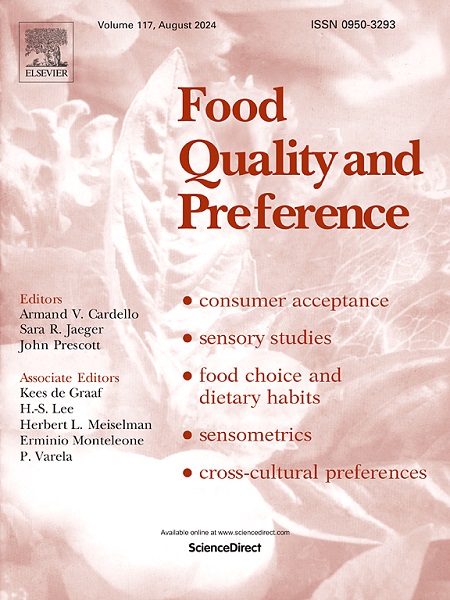A quantitative equation for umami evaluation of food and condiments based on the Weber-Fechner law
IF 4.9
1区 农林科学
Q1 FOOD SCIENCE & TECHNOLOGY
引用次数: 0
Abstract
Here, a quantitative equation for Overall Umami Strength (OUS) in foods and condiments, based on sensory evaluation, was defined using the Weber-Fechner law. Sensory evaluation was conducted utilizing objective questions grounded in triangulation tests and paired comparisons to accurately determine the absolute and difference thresholds for monosodium glutamate (MSG). These thresholds were employed to define various levels of umami strength, which facilitated the creation of an umami sensory difference strength curve. Subsequently, the OUS equation was constructed through a well-fitting function, represented as “” (R2 = 0.996). Once the relative MSG concentration of the sample is determined, it can be converted into the OUS value under the thresholds scale mentioned above for quantification. To validate this quantitative equation, multiple samples, including fish, mushrooms, and soy sauce, were evaluated using the paired comparison test to obtain relative MSG concentration. The OUS value calculated by relative MSG concentration was compared with the existing method to verify its correctness and effectiveness. The results demonstrate that both foods and condiments, even from different species origins, can be reliably quantified for overall umami intensity using the proposed sensory quantitative equation.
基于韦伯-费希纳定律的食品和调味品鲜味评估定量公式
在此,利用韦伯-费希纳定律,基于感官评估,定义了食品和调味品中整体鲜味强度(OUS)的定量方程。感官评估是利用基于三角测量和配对比较的客观问题进行的,以准确确定味精(MSG)的绝对阈值和差异阈值。这些阈值被用来定义不同级别的鲜味强度,从而有助于创建鲜味感官差异强度曲线。随后,通过拟合良好的函数构建了 OUS 方程,即 "OUS=9.6828×log10(CMSG)+34.8"(R2 = 0.996)。一旦确定了样品的相对味精浓度,就可以根据上述阈值比例将其转换为 OUS 值,进行定量。为了验证这一定量方程,我们使用配对比较试验对多个样品(包括鱼、蘑菇和酱油)进行了评估,以得出相对味精浓度。用相对味精浓度计算出的 OUS 值与现有方法进行了比较,以验证其正确性和有效性。结果表明,使用所提出的感官定量方程,可以可靠地量化食品和调味品的总体鲜味强度,即使是来自不同物种产地的食品和调味品。
本文章由计算机程序翻译,如有差异,请以英文原文为准。
求助全文
约1分钟内获得全文
求助全文
来源期刊

Food Quality and Preference
工程技术-食品科技
CiteScore
10.40
自引率
15.10%
发文量
263
审稿时长
38 days
期刊介绍:
Food Quality and Preference is a journal devoted to sensory, consumer and behavioural research in food and non-food products. It publishes original research, critical reviews, and short communications in sensory and consumer science, and sensometrics. In addition, the journal publishes special invited issues on important timely topics and from relevant conferences. These are aimed at bridging the gap between research and application, bringing together authors and readers in consumer and market research, sensory science, sensometrics and sensory evaluation, nutrition and food choice, as well as food research, product development and sensory quality assurance. Submissions to Food Quality and Preference are limited to papers that include some form of human measurement; papers that are limited to physical/chemical measures or the routine application of sensory, consumer or econometric analysis will not be considered unless they specifically make a novel scientific contribution in line with the journal''s coverage as outlined below.
 求助内容:
求助内容: 应助结果提醒方式:
应助结果提醒方式:


